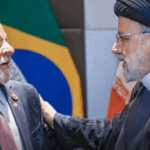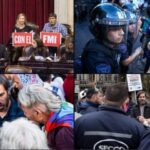
One of the key issues in the Venezuelan election has been the debate over the results. The CNE (National Electoral Council) has purposefully avoided making them available, even when the international community has pressured them to do so and when the mandatory 48 hours to publish them have expired. The CNE website—which is supposed to publish results by polling station, center, municipality, and state—remains offline. Meanwhile, candidate Edmundo González and opposition leader Maria Corina Machado have uploaded the results collected by election witnesses and made them available online, showing González Urrutia’s landslide victory over Maduro.
In response to the CNE’s continued silence on the matter, accusations have emerged that the Venezuelan government is fabricating fake minutes, which it will present as evidence of its victory. Former Colombian Vice President Francisco Santos said that Chinese engineers who had come from Cuba were working with CNE officials in a warehouse dedicated exclusively to falsifying minutes.
We thought it would be helpful to explain how and why falsifying minutes would be nearly impossible, or at least very easy to detect.
How do minutes work?
For years, Venezuelans have been voting using machines. For this election, voters first presented their cédula (national identity card), whose number was entered by polling station staff into a captahuella (a biometric identity verification machine), and then had their fingerprint scanned for identity verification. They then went to the voting booth and selected their candidate on a screen. Once confirmed, the machine recorded the vote and printed a boleta, a paper confirmation of the selected vote.
Once voting is complete and the table is closed, the voting machine transmits the minutes electronically and prints the minutes. The minutes are a paper printout containing all the relevant voting data for the day and serve as physical evidence of the results.
How do you know if a report is real?
Minutes have a 32-digit alphanumeric code at the top. This code is known as a “hash.” A hash is a function that converts an input of letters and numbers into an encrypted output of a fixed length. In other words, a hash takes any piece of information and encrypts it into a code that has a set number of digits. It’s like a fingerprint for a document. In the case of minutes, each minute is encrypted into a 32-digit alphanumeric hash.
The minutes were also physically signed by electoral witnesses. Finally, they have a “digital signature”, a code other than the hash, at the bottom.
How can you falsify a report?
I can think of two different ways to falsify a record, with different levels of sophistication.
The first is to try to get the machine to print new minutes. This, says electoral journalist Eugenio Martínez, is not feasible because it would require a shared key: one part is in the hands of the CNE and the rest is in the hands of each political party. Without a shared key, there is no access to the machines.
The second is to falsify the minutes: to print new, entirely false ones. This is physically possible, but it presents a number of challenges.
First, the sheer effort of producing a new record per polling station, 30,026 in total, and making them look identical to the originals, would be enormous. They would have to match QR code by QR code, hash by hash, and forge tens of thousands of witness signatures to make them look identical. But suppose they can overcome that particular hurdle.
Comparing the forged records to the real ones and verifying the results would be easy, as electoral journalist Eugenio Martínez explained in this thread . According to Martínez, you can verify the authenticity of the hash. You can compare the record to the data in the poll books and the citizen verification counts, and make sure all three match. You can use the QR code to verify the information. You can then verify the identities of the witnesses and see if they saved photos of their records. Thousands of them are already on social media for anyone to see.
In short, even in the case of a blatant forgery, there are robust methods of fact-checking.
What this means?
On the evening of Sunday, July 28, the National Electoral Council (CNE) interrupted the electronic transmission of the results at about 30%, and CNE President Elvis Amoroso announced Nicolás Maduro as Re-elected President with 51.2% of the vote against Edmundo González’s 44.2%. He claimed that 80% of the votes had been transmitted, but did not present evidence or a detailed vote count. Shortly after, Edmundo González and María Corina Machado denied Amoroso’s results, claiming that they had about 40% of the results, and showed a large advantage for González over Maduro. Amoroso proclaimed Maduro as President the following day in an official act that is usually held after the results have been verified and irregularities have been resolved. González and Machado, on the other hand, have continued to collect minutes and publish their results, recently publishing 81.21% of the minutes on an openly verifiable website, which shows a victory for González with 67% of the votes counted.
It is difficult to predict whether Chavismo will, in fact, resort to falsified records. But everyone should know why and how you can tell the difference.
Via Caracas Chronicles
Source: https://www.ocafezinho.com/2024/08/02/venezuela-especialistas-dizem-que-a-falsificacao-das-atas-e-quase-impossivel/

